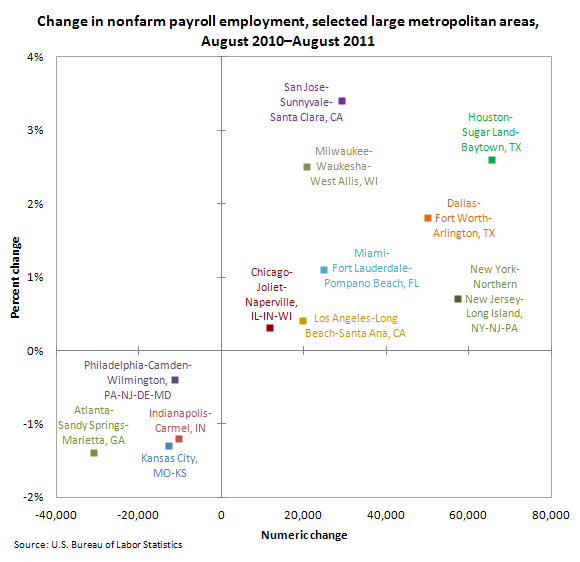September 30, 2011 (The Editor’s Desk is updated each business day.)
Employment in large metropolitan areas, August 2011
The largest over-the-year percentage increases in nonfarm payroll employment among large metropolitan areas (those with annual average employment levels above 750,000 in 2010) were in San Jose-Sunnyvale-Santa Clara, California (+3.4 percent); Houston-Sugar Land-Baytown, Texas (+2.6 percent); and Milwaukee-Waukesha-West Allis, Wisconsin (+2.5 percent).

[Chart data]
The largest over-the-year percentage decreases in employment among large metropolitan areas occurred in Atlanta-Sandy Springs-Marietta, Georgia (−1.4 percent); Kansas City, Missouri-Kansas (−1.3 percent); and Indianapolis-Carmel, Indiana (−1.2 percent).
The largest over-the-year employment increase occurred in Houston-Sugar Land-Baytown, Texas (+65,600), followed by New York-Northern New Jersey-Long Island, New York-New Jersey-Pennsylvania. (+57,400). The largest over-the-year decreases in employment occurred in Atlanta-Sandy Springs-Marietta, Georgia (−30,800), and Kansas City, Missouri-Kansas (−12,600).
Over the year, from August 2010 to August 2011, nonfarm employment rose in 29 of the 36 large metropolitan areas.
Of the nation's 372 metropolitan areas (of all sizes), 238 reported over-the-year increases in nonfarm payroll employment, 127 reported decreases, and 7 had no change in August.
These data are from the Current Employment Statistics (State and Metropolitan Area) program. For more information, see "Metropolitan Area Employment and Unemployment – August 2011" (HTML) (PDF), news release USDL-11-1396. Data for the most recent month are preliminary and subject to revision.
Related TED articles
Employment |
Metropolitan areas and counties
Of interest
Spotlight on Statistics: National Hispanic Heritage Month
In this Spotlight, we take a look at the Hispanic labor force—including labor force participation, employment and unemployment, educational attainment, geographic location, country of birth, earnings, consumer expenditures, time use, workplace injuries, and employment projections.
.
Read more »
